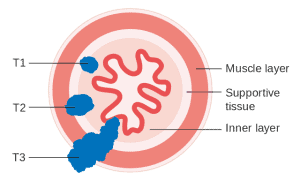
Hernias
Introduction and Definitions A hernia is – a protrusion of a viscous out of a containing cavity - i.e. when a structure passes through an anatomical barrier and ends up…

Introduction and Definitions A hernia is – a protrusion of a viscous out of a containing cavity - i.e. when a structure passes through an anatomical barrier and ends up…
A hiatus hernia occurs when part of the stomach protrudes through the diaphragm up into the thoracic cavity. There are two types; sliding hiatus hernia and rolling hiatus hernia. Sliding hiatus…
Introduction Intussusception is a condition affecting children where-by one section of bowel will ‘telescope’ inside an adjacent section, resulting in bowel obstruction, and if left untreated - bowel ischaemia. Usually…
Introduction Large bowel obstruction causes a less severe disease than small small bowel obstruction Symptoms are more gradual in onset There are often loud borborygmi (normal bowel sounds) Rectum is…

Introduction Obstructive Jaundice is a fairly common presentation to the emergency department and surgical teams. The most common cause is gallstones. You may also want to read about Gallstones and…

Summary There are 4 types of oesophageal tumour; adenocarcinoma, squamous cell carcinoma, leiomyoma and squamous papilloma. Squamous cell and adenocarcinoma are by far the most common. Squamous cell carcinoma Epidemiology…
Fibroadenoma the most common benign breast lump can occur from any age after puberty most common in the third decade Usually unifocal, but can be multiple. Pathology Made up of…

Introduction Paget's disease of the breast (aka Paget's disease of the nipple) is a form of breast cancer which is malignant and which has an eczematous appearance, involving the nipple.…
Introduction Pancreatic cancers are 95% exocrine, adenocarcinomas. These affect the duct or surround the duct. The remaining 5% are neuroendocrine tumours e.g. insulinomas, glucagonomas (the former being the more common).…
Introduction Pancreatitis is a condition involving inflammation of the pancreas. It can be acute or chronic; acute pancreatitis can return to normal after resolution of the episode, conversely chronic pancreatitis, is continuing…